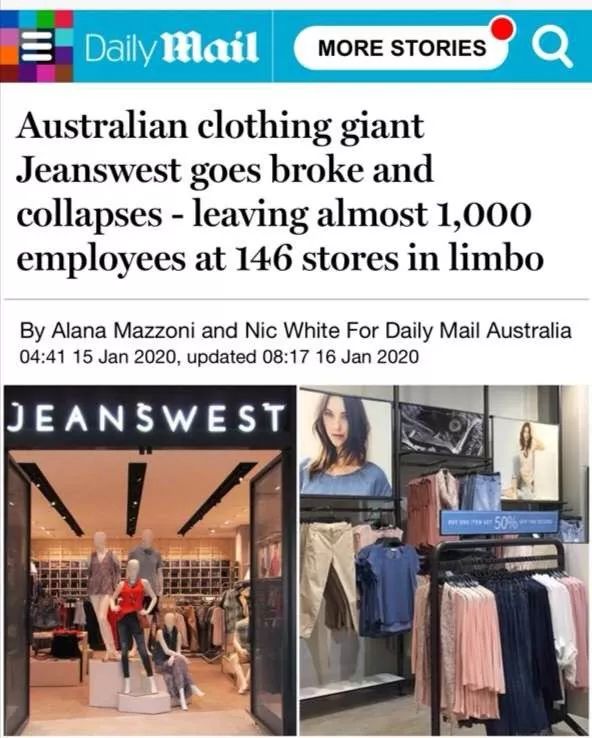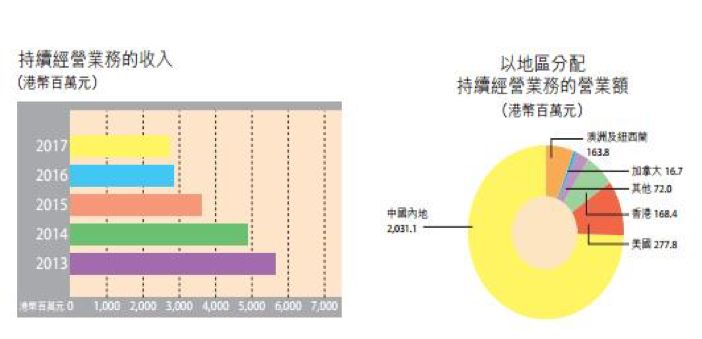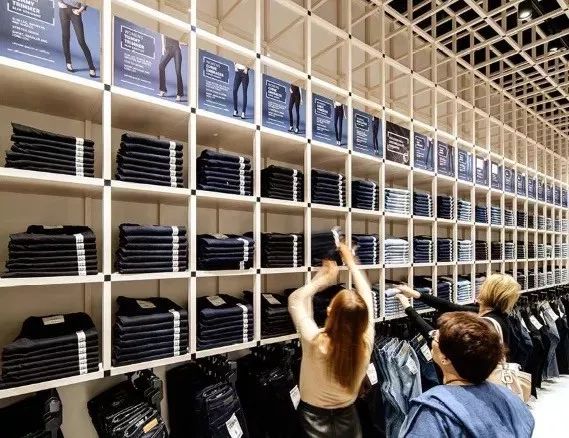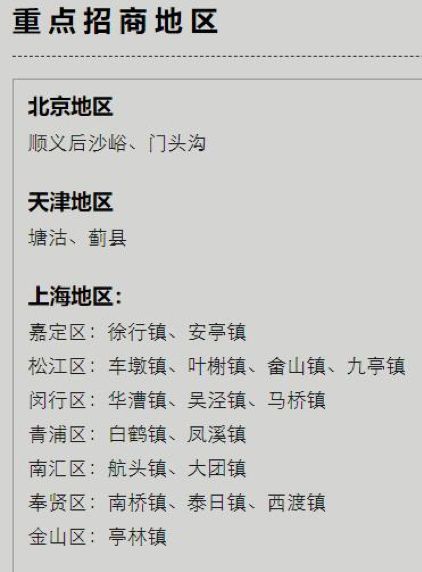How once the first casual wear brand failed.
Editor’s note: This article is from WeChat public account “ Public Reference ” (ID : Gongkaicankao), author Du Boqi.

On January 15th, according to the Daily Mail, Zenith Australia entered the voluntary escrow process and entered the bankruptcy liquidation stage.
Australia is the birthplace of Zenith. Founded in 1972 in Perth, Australia’s fourth largest city, in 1972, JEANSWEST was reversely acquired by its upstream suppliers, Yang Zhao and Yang Xun, and quickly became the second largest in the Australian market.
In 2015, Zenith achieved a pre-tax profit of HK $ 7.55 million in the Australian and New Zealand markets. Pre-tax losses in 2016 exceeded HK $ 80 million.
At present, Zhenweisi has 146 stores and 1,000 employees in Australia. The official website of Zhenweisi Australia can still be accessed normally. They will then be audited by KPMG and face the fate of restructuring or sale.
It’s ridiculous that Zenith has failed in Australia and it’s not much better in the Chinese mainland market.
Closed 1,300 stores, is it really worth selling?
In 1974, Yang Zhao and Yang Xun used the money from part-time jobs to set up the Rising Sun Garment Factory in Hong Kong, and made the first bucket of gold by making jeans.
JEANSWEST and GAP are their customers. They carefully studied GAP, and after the acquisition of Zhenweis, they set their own goals: “make Zhenweis into a Chinese gap, and make Chinese own brands in the casual clothing market.”
AmbitionTo be a “China GAP”, Zhenweis entered the mainland of China in 1993, and its sales exceeded 1.8 billion in 2004, becoming the industry champion.
At that time, Zhenweis formulated a “three five-year plan”: sales reached 4 billion in the first five years, 6 billion in the second five years, and exceeded 10 billion in the third five years. However, up to now its sales revenue in China has not exceeded 5 billion Hong Kong dollars.

In the peak of 2012, Zenith ’s highest turnover in the Chinese market was only 4.9 billion Hong Kong dollars, and it has been declining year after year. By 2017, China ’s revenue was only 1.6 billion Hong Kong dollars, and its production loss was 46 million Hong Kong dollars. In the first half of the year, more than 45 million Hong Kong dollars were lost. Since 2013, Zenith’s performance in the Chinese mainland market has fallen by 65%, closing more than 1,300 stores.
In 2018, Zenith’s parent company, Rising Sun, sold Zenith’s mainland China retail business to the major shareholders Yang Zhao and Yang Xun for $ 800 million.
At the time, Zhenweisi entered the South China market, and a store set a record of RMB 680 million. Contrast this time with the past.
Zhenweisi is not a case. Its decline represents a group of people who enjoy the dividends of the times. After the thousand sails have passed, they reluctantly withdraw from the stage.
E-commerce got up early and caught up late
Jin Weiss, who has been losing ground, has once made a seemingly correct explanation of his situation: he has been hit by the Internet.
However, Zhenweisi started to enter the e-commerce channel as early as 2009. Among the peers, GAP, Meibang and Semir did not touch the Internet until around 2011. In 2017, Zhenweis also specially established the “Zhenweis E-commerce Branch” to operate its online business independently.
However, the main role of e-commerce is to assist physical stores in handling out-of-season tail goods, playing a role of “destocking”.

The independently-operated Semir e-commerce online sales in 2017 exceeded 5 billion yuan, compared withBelow, Zenith’s e-commerce strategy is undoubtedly a failure.
In July 2018, after visiting the Hema Xiansheng in Shenzhen, the research staff of Zhenweis wrote a report with novel brush strokes, which mentioned: “Combining online and offline business, cashless consumption model, a radius of three kilometers Delivery within half an hour to enhance customer experience. ” This enterprise that started information construction in 1989 has become an awkward bystander in the new retail era.
Enjoy the dividends of the times
In 1993, Zhenweisi went to Shanghai to open the first store in mainland China. The customer base is located in the working class between the ages of 18 and 40. A pair of jeans costs hundreds of yuan, which is not cheap. However, because of its novel style, outstanding quality, and decent service, customers can go to any place within seven days if they are not satisfied or find quality problems A store returns and exchanges, making the working class feel more respected.
Therefore, when Zenith opens stores in many Chinese cities, there are scenes of queuing into the store. On the day of the opening of the first store in Qingdao, Zhenweis also invited dozens of security guards to maintain order. On the same day, the store sold more than 100,000 yuan of clothing at one go.
In fact, Zhenweisi is not an example. It works with the Hong Kong clothing brands of the era such as Benilu, esprit, Giordano, and Bossini, bringing Chinese clothing brand awareness to the Chinese consumers and eating the Chinese economy after the reform and opening up. Soaring first dividend. The combination of “International Design + Hong Kong Brand + Mainland Market + Made in China” has also won them more than a decade of opportunities.

In 1995, the Yang brothers moved the factory from Hong Kong to their hometown of Huizhou, Guangdong, and the cost dropped by more than 20%. They also built the headquarters of Zhenweis here, and opened more than 170 stores in dozens of cities at one time. At that time, the media Depicting it as “the most popular casual clothing brand in mainland China”, the strong performance helped the parent company Rising Sun land on the Hong Kong Stock Exchange in 1996.
At this time, in Mainland China, baptized by Hong Kong clothing chain brands, Wenzhou people Zhou Chengjian, Qiu Guang, and Metersbonwe and Semir successively established. Followers of “Xiao He only showed sharp corners”, from Zhenweis and Benilu After the “brand goods” learned about brand operation and chain expansion, they learned to arrange production plans for spring, summer, autumn and winter in a year, and eventually eat away their market share.
Who would buy Zenith?
Since 2000, the performance of Zhenweis in Mainland China has declined rapidly.The stock price of Si Rising Sun also fell.
The Yang brothers believe that the largest consumer clothing consumer group in China is the working class. They have limited income. Although they like popular clothing, they cannot afford it. As a result, Zhenweisi took the initiative to lay down his body and strategically adjusted it to “popularization of famous brands”, reducing the brand name to a mid-range brand, and expanding madly to third- and fourth-tier cities and even counties. Yang Xun said: If Zhenweisi’s market positioning is to guide the trend, or to create fashion, it may not go so long. “Light design requires a lot of investment, and the risks are much greater.”
This decision brought a decade-long high-speed growth to Zhenweisi, and also led to its complete defeat in the era of consumption upgrade.
Today, the key investment areas of Zhenweisi have been sunk to counties and even towns, such as Tianjin Jixian, Beijing Mentougou, Tinglin Town, Shanghai Chuo Town, and so on. And in the prime locations of first- and second-tier cities, we have already seen it.

A user who really liked Zenith in high school said, “When you see it in many counties, you know it’s dead.”
The Internet makes information more and more transparent. The days of rewriting foreign styles and selling them are over. It is necessary to come up with products that meet consumer tastes. This tests not only production capacity, but also fashion. Ability to grasp and perceive. And Zhenweisi is by no means a case, and Metersbonwe, which has been losing money for many years, has also targeted third-tier to fifth-tier cities and launched the strategy of “hundred cities and thousands of stores”. This looks like a way out, but when it gives up more difficult and important capacity building, it may follow in the footsteps of True Weiss.
When H & M and Uniqlo are expanding wildly in first and second tier cities, Zhenweis can only go to third and fifth tier cities to find living space; when consumers in third, fourth and fifth tier cities can buy GAP through Taobao and Tmall, they Still willing to buy “Chinese gap”?

Jin Weiss, who has been losing ground, has once made a seemingly correct explanation of his situation: he has been hit by the Internet.
However, Zhenweisi started to enter the e-commerce channel as early as 2009. Among the peers, GAP, Meibang and Semir did not touch the Internet until around 2011. In 2017, Zhenweis also specially established the “Zhenweis E-commerce Branch” to operate its online business independently.
However, the main role of e-commerce is to assist physical stores in handling out-of-season tail goods, playing a role of “destocking”.

The independently-operated Semir e-commerce online sales in 2017 exceeded 5 billion yuan, compared withBelow, Zenith’s e-commerce strategy is undoubtedly a failure.
In July 2018, after visiting the Hema Xiansheng in Shenzhen, the research staff of Zhenweis wrote a report with novel brush strokes, which mentioned: “Combining online and offline business, cashless consumption model, a radius of three kilometers Delivery within half an hour to enhance customer experience. ” This enterprise that started information construction in 1989 has become an awkward bystander in the new retail era.
Enjoy the dividends of the times
In 1993, Zhenweisi went to Shanghai to open the first store in mainland China. The customer base is located in the working class between the ages of 18 and 40. A pair of jeans costs hundreds of yuan, which is not cheap. However, because of its novel style, outstanding quality, and decent service, customers can go to any place within seven days if they are not satisfied or find quality problems A store returns and exchanges, making the working class feel more respected.
Therefore, when Zenith opens stores in many Chinese cities, there are scenes of queuing into the store. On the day of the opening of the first store in Qingdao, Zhenweis also invited dozens of security guards to maintain order. On the same day, the store sold more than 100,000 yuan of clothing at one go.
In fact, Zhenweisi is not an example. It works with the Hong Kong clothing brands of the era such as Benilu, esprit, Giordano, and Bossini, bringing Chinese clothing brand awareness to the Chinese consumers and eating the Chinese economy after the reform and opening up. Soaring first dividend. The combination of “International Design + Hong Kong Brand + Mainland Market + Made in China” has also won them more than a decade of opportunities.

In 1995, the Yang brothers moved the factory from Hong Kong to their hometown of Huizhou, Guangdong, and the cost dropped by more than 20%. They also built the headquarters of Zhenweis here, and opened more than 170 stores in dozens of cities at one time. At that time, the media Depicting it as “the most popular casual clothing brand in mainland China”, the strong performance helped the parent company Rising Sun land on the Hong Kong Stock Exchange in 1996.
At this time, in Mainland China, baptized by Hong Kong clothing chain brands, Wenzhou people Zhou Chengjian, Qiu Guang, and Metersbonwe and Semir successively established. Followers of “Xiao He only showed sharp corners”, from Zhenweis and Benilu After the “brand goods” learned about brand operation and chain expansion, they learned to arrange production plans for spring, summer, autumn and winter in a year, and eventually eat away their market share.
Who would buy Zenith?
Since 2000, the performance of Zhenweis in Mainland China has declined rapidly.The stock price of Si Rising Sun also fell.
The Yang brothers believe that the largest consumer clothing consumer group in China is the working class. They have limited income. Although they like popular clothing, they cannot afford it. As a result, Zhenweisi took the initiative to lay down his body and strategically adjusted it to “popularization of famous brands”, reducing the brand name to a mid-range brand, and expanding madly to third- and fourth-tier cities and even counties. Yang Xun said: If Zhenweisi’s market positioning is to guide the trend, or to create fashion, it may not go so long. “Light design requires a lot of investment, and the risks are much greater.”
This decision brought a decade-long high-speed growth to Zhenweisi, and also led to its complete defeat in the era of consumption upgrade.
Today, the key investment areas of Zhenweisi have been sunk to counties and even towns, such as Tianjin Jixian, Beijing Mentougou, Tinglin Town, Shanghai Chuo Town, and so on. And in the prime locations of first- and second-tier cities, we have already seen it.

A user who really liked Zenith in high school said, “When you see it in many counties, you know it’s dead.”
The Internet makes information more and more transparent. The days of rewriting foreign styles and selling them are over. It is necessary to come up with products that meet consumer tastes. This tests not only production capacity, but also fashion. Ability to grasp and perceive. And Zhenweisi is by no means a case, and Metersbonwe, which has been losing money for many years, has also targeted third-tier to fifth-tier cities and launched the strategy of “hundred cities and thousands of stores”. This looks like a way out, but when it gives up more difficult and important capacity building, it may follow in the footsteps of True Weiss.
When H & M and Uniqlo are expanding wildly in first and second tier cities, Zhenweis can only go to third and fifth tier cities to find living space; when consumers in third, fourth and fifth tier cities can buy GAP through Taobao and Tmall, they Still willing to buy “Chinese gap”?

Since 2000, the performance of Zhenweis in Mainland China has declined rapidly.The stock price of Si Rising Sun also fell.
The Yang brothers believe that the largest consumer clothing consumer group in China is the working class. They have limited income. Although they like popular clothing, they cannot afford it. As a result, Zhenweisi took the initiative to lay down his body and strategically adjusted it to “popularization of famous brands”, reducing the brand name to a mid-range brand, and expanding madly to third- and fourth-tier cities and even counties. Yang Xun said: If Zhenweisi’s market positioning is to guide the trend, or to create fashion, it may not go so long. “Light design requires a lot of investment, and the risks are much greater.”
This decision brought a decade-long high-speed growth to Zhenweisi, and also led to its complete defeat in the era of consumption upgrade.
Today, the key investment areas of Zhenweisi have been sunk to counties and even towns, such as Tianjin Jixian, Beijing Mentougou, Tinglin Town, Shanghai Chuo Town, and so on. And in the prime locations of first- and second-tier cities, we have already seen it.

A user who really liked Zenith in high school said, “When you see it in many counties, you know it’s dead.”
The Internet makes information more and more transparent. The days of rewriting foreign styles and selling them are over. It is necessary to come up with products that meet consumer tastes. This tests not only production capacity, but also fashion. Ability to grasp and perceive. And Zhenweisi is by no means a case, and Metersbonwe, which has been losing money for many years, has also targeted third-tier to fifth-tier cities and launched the strategy of “hundred cities and thousands of stores”. This looks like a way out, but when it gives up more difficult and important capacity building, it may follow in the footsteps of True Weiss.
When H & M and Uniqlo are expanding wildly in first and second tier cities, Zhenweis can only go to third and fifth tier cities to find living space; when consumers in third, fourth and fifth tier cities can buy GAP through Taobao and Tmall, they Still willing to buy “Chinese gap”?